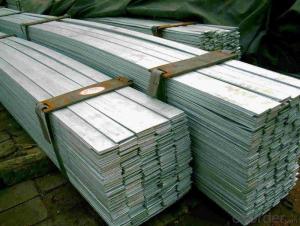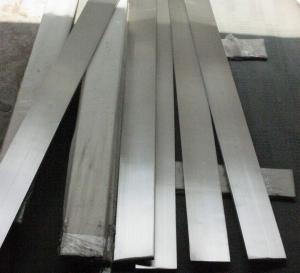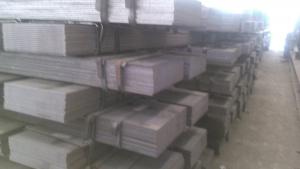Galvanized Steel Flat Bar
- Loading Port:
- China Main Port
- Payment Terms:
- TT or LC
- Min Order Qty:
- -
- Supply Capability:
- 10000 m.t./month
OKorder Service Pledge
OKorder Financial Service
You Might Also Like
Specification of Carbon Steel Flat Bar
Commodity: Carbon Steel Flat Bar
Standard: GB, JIS, ASTM,
Material: Q235, SS400 or Equivalent
Origin place: China
Thickness: 3mm-30mm
Width:20mm-200mm
Length: Max 12m
Certification: SGS/BV
Chemical composition of Q235
Alloy No | Grade | Element(%) | ||||
C | Mn | S | P | Si | ||
Q235 | B | 0.12—0.20 | 0.3—0.7 | ≤0.045 | ≤0.045 | ≤0.3 |
Physical properties of Q235
Alloy No | Grade | Yielding strength point(Mpa) | Tensile strength (Mpa) | Elongation after fracture(%) | ||||||
Thickness (mm) | Thickness (mm) | |||||||||
≤16 | >16--40 | >40--60 | >60--100 | ≤16 | >16--40 | >40--60 | >60--100 | |||
≥ | ≥ | |||||||||
Q235 | B | 235 | 225 | 215 | 205 | 375--500 | 26 | 25 | 24 | 23 |
Usage/Applications of Carbon Steel Flat Bar
Widely used for construction;
Machinery manufacturing;
Iron tower steel structure;
Shipbuilding; Steel grating;
Staircase;
Bridge;
Viaduct;
Railway spare parts;
Boilers making etc.
Packaging & Delivery of Carbon Steel Flat Bar
Packaging Details: The Steel Flat Bars are packed in bundles and loaded in 20 feet/40 feet container, or shipped by bulk cargo ,also we can do as customer's requirements.
Delivery Details:30~45 days upon the receipt of buyer payment by T.T. or L/C.
Production Flow of Carbon Steel Flat Bar
The Carbon Steel Flat Bar is made through three processes:
1.Feeding the material: Feeding the row material (the steel plate) to Slitting Line.
2.Slitting:The steel plate would be slitted into expected width by lengthways cutter.
3. Leveled and cutting: The plat bar would be ground into level by the grinder and then cut into required length.
FAQ:
Q1: Why buy Materials & Equipment from OKorder.com?
A1: All products offered byOKorder.com are carefully selected from China's most reliable manufacturing enterprises. Through its ISO certifications, OKorder.com adheres to the highest standards and a commitment to supply chain safety and customer satisfaction.
Q2: How do we guarantee the quality of our products?
A2: We have established an advanced quality management system which conducts strict quality tests at every step, from raw materials to the final product. At the same time, we provide extensive follow-up service assurances as required.
Q3: What makes stainless steel stainless?
A3: Stainless steel must contain at least 10.5 % chromium. It is this element that reacts with the oxygen in the air to form a complex chrome-oxide surface layer that is invisible but strong enough to prevent further oxygen from "staining" (rusting) the surface. Higher levels of chromium and the addition of other alloying elements such as nickel and molybdenum enhance this surface layer and improve the corrosion resistance of the stainless material.
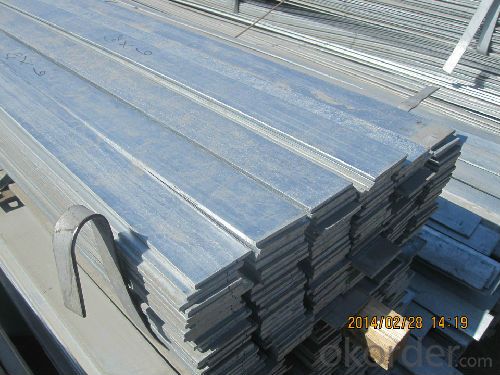
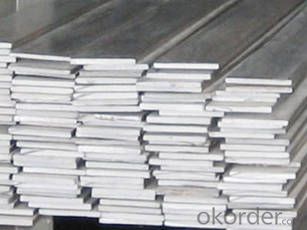
- Q:Can steel flat bars be used for manufacturing railway components or tracks?
- Yes, steel flat bars can be used for manufacturing railway components or tracks. Steel flat bars are commonly used in railway construction due to their strength, durability, and ability to withstand heavy loads. They are often utilized for creating various railway components such as rails, sleepers, and fasteners, as well as for track reinforcement and support.
- Q:Can steel flat bars be used as support beams?
- Yes, steel flat bars can be used as support beams as they have high strength and load-bearing capacity. However, it is important to consider the specific requirements and structural calculations to ensure they are suitable for the intended purpose and meet the necessary safety standards.
- Q:How do steel flat bars behave under high temperatures?
- Steel flat bars behave differently under high temperatures depending on the specific grade and composition of the steel. However, in general, steel flat bars tend to lose their strength and stiffness when exposed to high temperatures. They may start to deform, buckle, or even melt if the temperature exceeds the steel's melting point. It is crucial to consider these factors when using steel flat bars in high-temperature applications to ensure structural integrity and safety.
- Q:What are the different thicknesses available for steel flat bars?
- Steel flat bars are available in a range of thicknesses to suit various applications and requirements. The thickness options for steel flat bars typically vary from 1/8 inch to 1 inch or even more, depending on the specific needs of the project. These different thicknesses allow for flexibility in designing and constructing structures that require strength, durability, and stability. The choice of the appropriate thickness depends on factors such as the intended use, load-bearing capacity, and structural integrity needed for the particular application.
- Q:Are steel flat bars suitable for the construction of walkways or catwalks?
- Steel flat bars are well-suited for the construction of walkways or catwalks due to their strength, durability, and versatility. These bars are known for their ability to withstand heavy loads and high foot traffic, providing a reliable and sturdy surface for walking. Moreover, they can be easily fabricated, cut, and welded to meet specific design requirements, allowing for customization and flexibility in construction projects. Additionally, their resistance to corrosion and weathering ensures that walkways or catwalks made from steel flat bars will have a longer lifespan and require minimal maintenance. Ultimately, steel flat bars are a popular and widely used material for constructing walkways or catwalks because of their strength, durability, and adaptability.
- Q:What are the weight and load-bearing capacities of different steel flat bar sizes?
- Steel flat bars can have varying weight and load-bearing capacities depending on their size. Generally, the larger the flat bar, the greater its weight and load-bearing capacity. Below are some common sizes of steel flat bars and their approximate weight and load-bearing capacities: 1. For a thin flat bar that is 1/8 inch thick, it is typically used for lighter applications. Its weight can range from around 0.42 pounds per foot, and its load-bearing capacity is approximately 200 pounds per foot. 2. If the flat bar is slightly thicker at 1/4 inch, it can handle heavier loads. It typically weighs around 0.85 pounds per foot and has a load-bearing capacity of about 400 pounds per foot. 3. A thicker option is the 3/8 inch steel flat bar, which can support even greater loads. Its weight can range from around 1.27 pounds per foot, and its load-bearing capacity is approximately 600 pounds per foot. 4. Significantly thicker, the 1/2 inch steel flat bar is commonly used for heavy-duty applications. It weighs around 1.7 pounds per foot and has a load-bearing capacity of about 800 pounds per foot. 5. For extremely heavy loads, the 1 inch thick steel flat bar is suitable. It typically weighs around 3.4 pounds per foot and has a load-bearing capacity of approximately 1600 pounds per foot. It is important to note that these weight and load-bearing capacities are approximate and can vary based on the grade and quality of the steel used. Other factors such as the length and support conditions of the flat bar should also be considered when determining its maximum load-bearing capacity. It is advisable to consult professional engineers or refer to load tables provided by steel manufacturers for accurate and specific information on the weight and load-bearing capacities of steel flat bars.
- Q:How are steel flat bars used in construction?
- Steel flat bars have a wide range of applications in construction. They are commonly used to provide structural support in buildings and infrastructure. By serving as beams or columns, they offer stability and strength to structures. Construction projects also make use of steel flat bars for framing and bracing purposes. These bars can be used to create robust frameworks for walls, roofs, and floors, forming a sturdy foundation for the rest of the building components. Furthermore, steel flat bars are utilized to reinforce concrete structures. They are often embedded within concrete slabs or walls to enhance strength and prevent cracking or structural failure. These bars act as tension members, evenly distributing forces and improving the overall durability of the concrete structure. Moreover, steel flat bars are employed in the manufacturing of various construction components like brackets, connectors, and supports. These components play a crucial role in joining different elements of a building together, ensuring stability and functionality. In conclusion, steel flat bars are indispensable in construction due to their ability to provide structural support, reinforce concrete, and manufacture essential components. Their versatility, strength, and durability make them a popular choice for many construction projects.
- Q:Are steel flat bars recyclable?
- It is true that steel flat bars can be recycled. Steel is widely known as one of the most frequently recycled materials globally because of its inherent characteristics. Its quality and strength remain intact even after being melted down and repurposed numerous times. By recycling steel flat bars, not only do we contribute to the preservation of natural resources, but we also decrease energy usage and greenhouse gas emissions compared to the production of new steel from raw materials. Recycling centers and scrap yards are available for accepting steel flat bars, providing an environmentally friendly alternative for disposing or repurposing these materials.
- Q:Are steel flat bars available in different colors?
- Steel flat bars do not come in various colors, I'm afraid. Usually, steel is manufactured with its inherent grey hue due to its composition and production process. Nonetheless, it is feasible to alter the color of steel flat bars by applying diverse coatings or paint. These coatings can offer extra defense against rust or purely serve aesthetic intentions.
- Q:How do steel flat bars compare to other types of steel profiles?
- Steel flat bars have several advantages compared to other types of steel profiles. Firstly, they have a flat surface that makes them ideal for applications where a smooth and even support is required. This characteristic also allows for easy welding, cutting, and shaping, making them versatile for various construction and manufacturing projects. Additionally, steel flat bars offer excellent strength and durability, making them suitable for structural purposes. They are also cost-effective and readily available, making them a popular choice in the industry. Overall, steel flat bars provide a great balance of strength, versatility, and affordability, making them a preferred option among other types of steel profiles.
1. Manufacturer Overview |
|
|---|---|
| Location | |
| Year Established | |
| Annual Output Value | |
| Main Markets | |
| Company Certifications | |
2. Manufacturer Certificates |
|
|---|---|
| a) Certification Name | |
| Range | |
| Reference | |
| Validity Period | |
3. Manufacturer Capability |
|
|---|---|
| a)Trade Capacity | |
| Nearest Port | |
| Export Percentage | |
| No.of Employees in Trade Department | |
| Language Spoken: | |
| b)Factory Information | |
| Factory Size: | |
| No. of Production Lines | |
| Contract Manufacturing | |
| Product Price Range | |
Send your message to us
Galvanized Steel Flat Bar
- Loading Port:
- China Main Port
- Payment Terms:
- TT or LC
- Min Order Qty:
- -
- Supply Capability:
- 10000 m.t./month
OKorder Service Pledge
OKorder Financial Service
Similar products
New products
Hot products
Hot Searches
Related keywords
